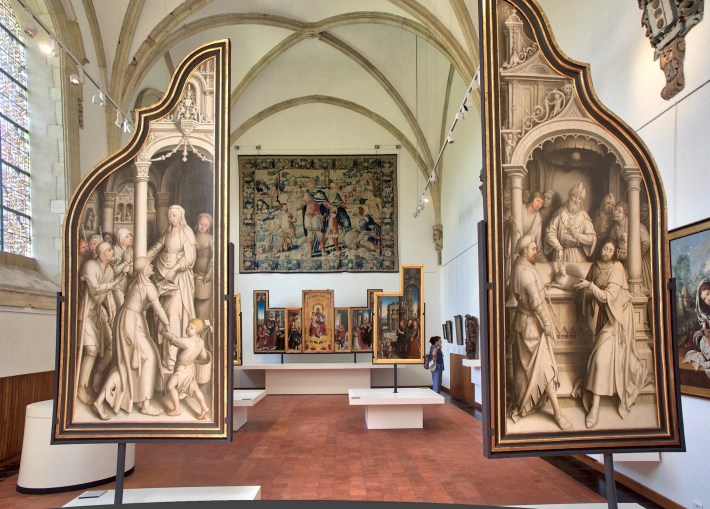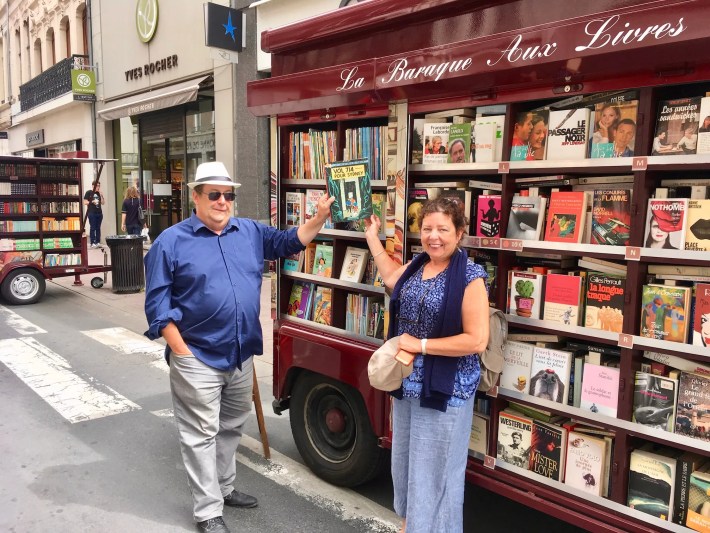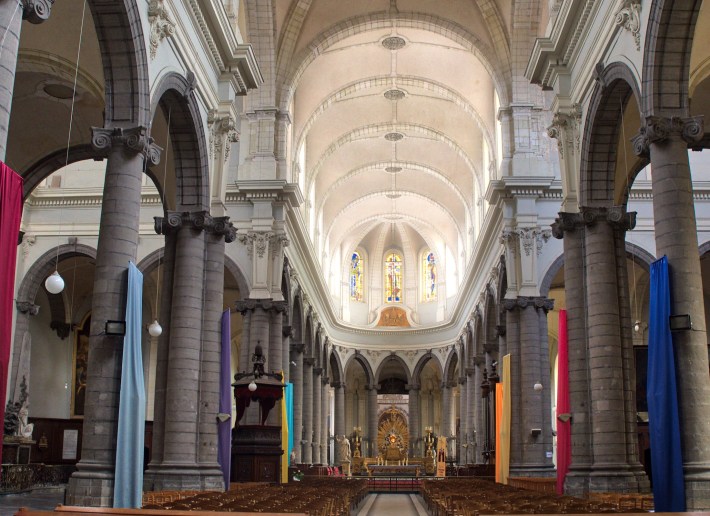Courchelettes
Honouring the proverb that “all work and no play makes Jack a dull boy”, we did not spend our time in the shipyard just sanding and painting. Indeed, we had a full social and touring experience to make this not only a productive stoppage but an enjoyable and interesting one.
Fellow Cruisers
As we mentioned, the shipyard itself hosted a number of other boats at various times and, in nearby Douai, there were two moorings where we spent time catching up with fellow cruisers. Over our time here we either went on board or chatted with all our new-found cruising friends. Most especially Craig and Stef on Liza and Debbie and Malcolm on Janna II – but see the photos below for details of some of the others with whom we swapped stories, often with a glass in hand.
Courchelettes
‘Courchelettes Resort’ (Chantier Despinoy) has no great tourist features but does have a friterie just across the canal and a well-provisioned Carrefour nearby – so it had the essentials.

The other attraction, which we enjoyed greatly, was watching the parade of barges and other vessels as they passed by. The mixture of peniches, double peniches, 85’s, pleasure barges and even one big river cruiser were always of interest whether we were sitting relaxing or hard at work. It is always a pleasure to look up from your paintbrush or sander and muse of the variety of craft travelling on this busy canal.
One, in particular, was striking. The 85 m commercial had a lovely burgundy and cream livery (although the hull re-blacking was plainly in progress) and like all commercials had their car on the stern. But, in this case, it was a lovely vintage car, also in matching cream and burgundy. Commercial bargees taker great pride in, and care of, their barges.
One day, just for something different to do, we were working outside, hoping to get another coat on before the next storm passed through, when we looked up and saw Val and Koos’ beautiful boat just exiting the canal opposite the shipyard. They saw us at the same time, and quickly changed direction to come alongside and raft up. We had a lovely catch-up over a coffee, and were treated to a video they had made of one of Koos’ compositions, played by him on guitar and Val on ukelele, in an abandoned factory they had discovered along the canal to Arras. Magic!

We don’t eat out all that often but, after we had been lifted out and were waiting (serially) for the water-pump, we had been moved alongside a peniche moored right outside a lovely restaurant “Restaurant des 4 Canaux”. It was only open lunchtimes except for Friday evening and was always well attended. We couldn’t pass up a restaurant right outside our door, so we took a break from work one day, washed off the grit and grime and presented ourselves.
Ian had wandered up to the restaurant earlier in the morning to check if we needed to book, but there was no problem at all. Ian had been speaking English, so when we both arrived for our long-anticipated meal, our host showed us to our seats using excellent English. However, he did revert to French on Lisette’s request – breaking into English from time to time to check his ‘restaurant-ese’. From his first ‘bon appetit‘- ‘how do you say this in English? We looked at each other and wondered what we really do say when our meal is served – perhaps ‘enjoy your meal’? With a flourish, he bowed low and asked that we ‘enjoy our meal’. He was totally charming and we had several long conversations over the two hours of lunch. Lisette decided to finish her meal with some petite fours but he arrived with an overfull platter explaining that his wife (the chef) insisted that Lisette have all the dessert selections. Ian, not surprisingly, chose the cheese selection. It was a marvellous and memorable meal, looking out over Catharina Elisabeth to the junction of the canals.
Douai
However, the centre of the much bigger town, Douai is about five km away. There was a pleasant, easy cycle ride that took about 15 min one way to get to the main part of town. By the end of our stay, we would have done that trip at least twenty times.

Douai itself has a population of a little over 40,000 and became part of France in the mid-17th century. It’s clean and well provisioned with shops. It rather lacks for a central square – it has one but it isn’t very interesting compared to others we have seen. However, there are several notable tourist attractions and it will come as no surprise that we visited them all.
Belfry and Town Hall
The Beffroi is in the centre of town and at 58 m is by far the tallest building around. It’s surrounded by other buildings, however, so hard to get an isolated photo.
Built around it is a striking town hall with wonderful contrasting brickwork.
The belfry is renowned for its carillon, the largest in Europe with 62 bells. Indeed, the local university is the only institution in France that offers a full course in bell ringing on the basis that the students are trained in the Douai belfry. The bells are generally played automatically but each Saturday morning, there is a short concert given by one of the master carillonneurs. Somehow, we never managed to be there at the right time for this one!
We did, however, have a very pleasant and informative tour of the Belfroi with Craig and Stef. The tour was hosted and while the guide explained the features in French to the rest of the tour, there was an audio device so we could trigger the equivalent descriptions when we were at each station. While we are keen to visit all of the Beffroi we come across, there is a range of access. Some will be shrouded in cloth and under repair and therefore inaccessible and some can only be visited if you join a tour. But occasionally you are able to wander around on your own, climbing to the very top and taking the time to gaze over the town below. They are all quite unique, and very beautiful structures. As with all belfries, its main original purpose was as watch tower with other civic duties such as detention and storage of documents as secondary features. All of us scaled the 192 steps to view the town from above.
The Town Hall was built around belfry and the tour took us through the Gothic Hall which was added in the 15th century. It featured a mural, ‘Joyous Entry of King John the Good at Douai, 1355’. A panoramic painting by Auguste François Marie Gorguet (1862-1927) painted between 1914 and 1916.
Musee de la Chartreuse
Sited in an old monastery the Musee de la Chartreuse is a smallish art and sculpture museum.
We took a leisurely couple of hours to wander around the exhibits which were interesting rather than spectacular.

However, there was a special exhibition of paintings of Mary Magdelene and one particularly took our eye. Painted by Alfred Stevens at the end of the 19th century, it features a sensual, pensive pose and was composed with the actress Sarah Bernhardt as the model.

Saint Peter’s Collegiate Church
Close to the centre of town is the striking St Peter’s Church. It has a brilliant almost golden yellow stone facade, which, in evening sun is glorious to behold. Again, the buildings around it make it hard to get a good photo, unfortunately, so we don’t have one of the dome that caps the other end of the church.
Inside it was ornate as usual and had a splendid altarpiece.
Out and About in Douai
Of course, we were regularly in town to get groceries and food. There were a couple of market days – a couple of small fresh produce markets on different days of the week and a larger clothing/toys market each Saturday. Each of the markets was staged in a different square around the town – a somewhat strange arrangement it seemed to us. One Saturday we happened upon a delightful mobile bookstore – a vintage Citroen van full of all types of books.
Lisette was desperate to buy a book. How could you leave empty-handed? Naturally, all were in French, and after browsing the displays, started to search for a “Tin Tin” book. The stories are translated into many languages, and we already have a French version of one of them on board Catharina. He looked a bit quizzical for a moment and then came back with “Tan Tan“? “Pardon je suis Australienne. Bien sûr! ‘Tan Tan’ s’il vous plaît” she replied, recognising the French pronunciation of the character. It’s a great way to learn! Anyhow, he walked around the van and reached in and, by good fortune, found for his Australian customers his only copy of this series “Tin-Tin: Flight 714 for Sydney”!

Nearby to Douai
Centre Historique Minier
One of the nearby attractions is a museum of coal mining. Situated in one of the last mines that operated in the region, it was located 13 km away from our mooring – so a nice ride on our electric bikes. This took us south along the canal that we were becoming desperate to travel in Catharina Elisabeth and, just as we turned inland, we passed a mooring where a number of peniches rested, bedecked with flags. We could see that there must have been a wedding aboard the foremost barge – and their barge community had clearly gathered for the celebration.
A little further on, cycling through one of the lovely villages that we passed through on our way, we were hailed by a couple and their daughter also on bikes, asking for directions to a nearby cycle path they had heard of. Of course, this was in French and, caught unawares, we replied in English. They immediately queried our nationality “Vous êtes Anglais?” to which we always reply “Non, nous sommes Australiens”. Then they continued the conversation in perfect English.
We couldn’t offer help but almost immediately we found out that they lived in Douai and were out for a weekend cycle. As soon as they found out we were moored in Courchelettes, we were invited for dinner! Of course, we accepted with alacrity and exchanged contact details. What lovely folks!
Smiling, we continued to the Lewarde Mining Heritage Centre.
Coal mining was the foundation of the prosperity in North France from 1734 until the 1960’s when it began to decline and is now non-existent. In large measure, this is why this a relatively economically disadvantaged part of France. Conical mullock heaps dot the countryside and there are hundreds of abandoned mines, pretty much all filled in. This mine was in operation from 1931 to 1971 and was converted to a heritage centre in 1984. There is a huge collection of mining artefacts and machinery but we found the displays of the culture of the mining communities the most interesting.

By and large, they lived in company towns with all their needs catered for. Housing, education, work of course, and churches with graveyards for those that died. Far too many of these were in mining accidents. One disaster, in 1906, killed 1,099 workers when one mine collapsed and caught fire.
Another fascinating display was of the underground workings of the mine. Some of the underground tunnels have been restored with working equipment and displays covering various stages of the development of coal mining techniques. As we were led to each ‘station’ there was a display of the protective clothing a miner would have worn at that time, along with the tools available to him. The tour starts in the interesting shower room. Here the miners cleaned up after their shift. They did not have lockers for clothes, instead, each one had a designated ‘hanger’ to which they attached their clothes and shoes and then hauled them up to the ceiling.
We were all given hard hats to wear and taken down in a rattling lift to the underground workings. The depth of descent is not specified but, having had previous experience in Antwerp of the theatre of (supposed) deep descents by mining lifts (lots of clatter and shaking but nothing else!), we were not surprised to find that we merely walked up a gentle incline to leave the tunnels at the end.

The guide led us around several displays and we were provided with an electronic audio device so that we could follow along in English at each station. Turning on noisy equipment and close inspection of many displays bought a little of the reality of a working mine to us.

In all, we spent about four hours in the Centre and could well have spent much more but, with a 13 km ride home and a dicey weather forecast for the evening, we left and returned to Catharina.
A French Dinner
A few days later, having been in touch with the French family we had met on our bike ride, we cycled into Douai to catch up with Laurence, Thierry and their daughter Louise to avail ourselves of our first evening meal hosted by a French family. Their lovely house was on one of the routes that we used to travel into Douai, backing onto the canal that runs right through the town, and we realised we had cycled past it often over the past few weeks.
So we found ourselves being hosted by this friendly French couple and their young daughter. Their house is several hundred years old, with 15-foot ceilings and they are gradually decorating it room by room. We had the most wonderful evening, with a fabulous meal and wine (we knew better than to take wine to a French house for dinner but we did take a number of Australian gifts as a thank you for their generosity), intelligent, engaging conversation and a promise to stay in touch.
Finally, quite replete and very late in the evening, we said ‘au revoir’ and set off to cycle back to Catharina, along the dark towpath, making it back just in time to dodge some heavy rain. A most memorable evening.
So, a good part of our time in Chantier Despinoy was spent in and around Douai but we also made a couple of side trips – and we’ll cover those in the next posting.












One Response
Lovely post, Ian and Lisette! Your photos are gorgeous and it was such a lovely surprise to read about our meet up and see the lovely photo of the HH. May I use it? I have caught up now and will comment on your latest post too ????